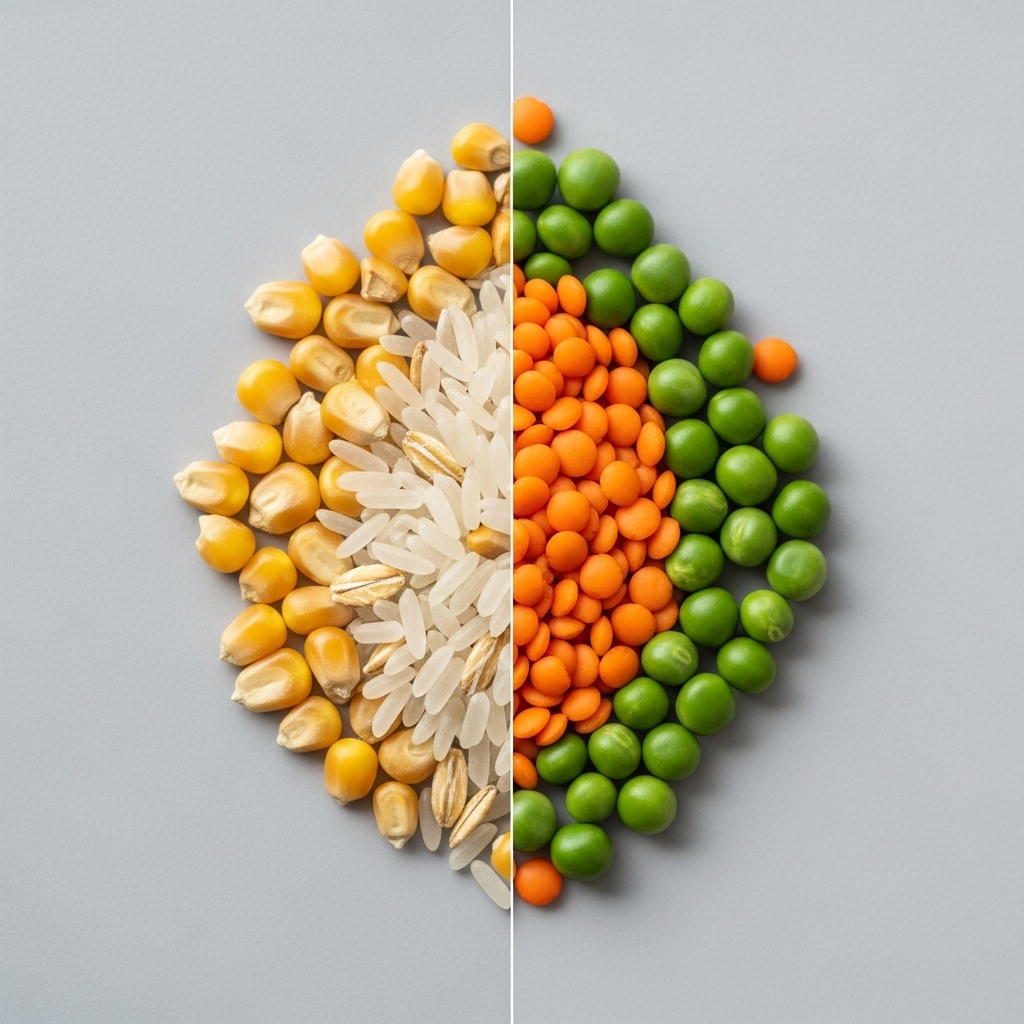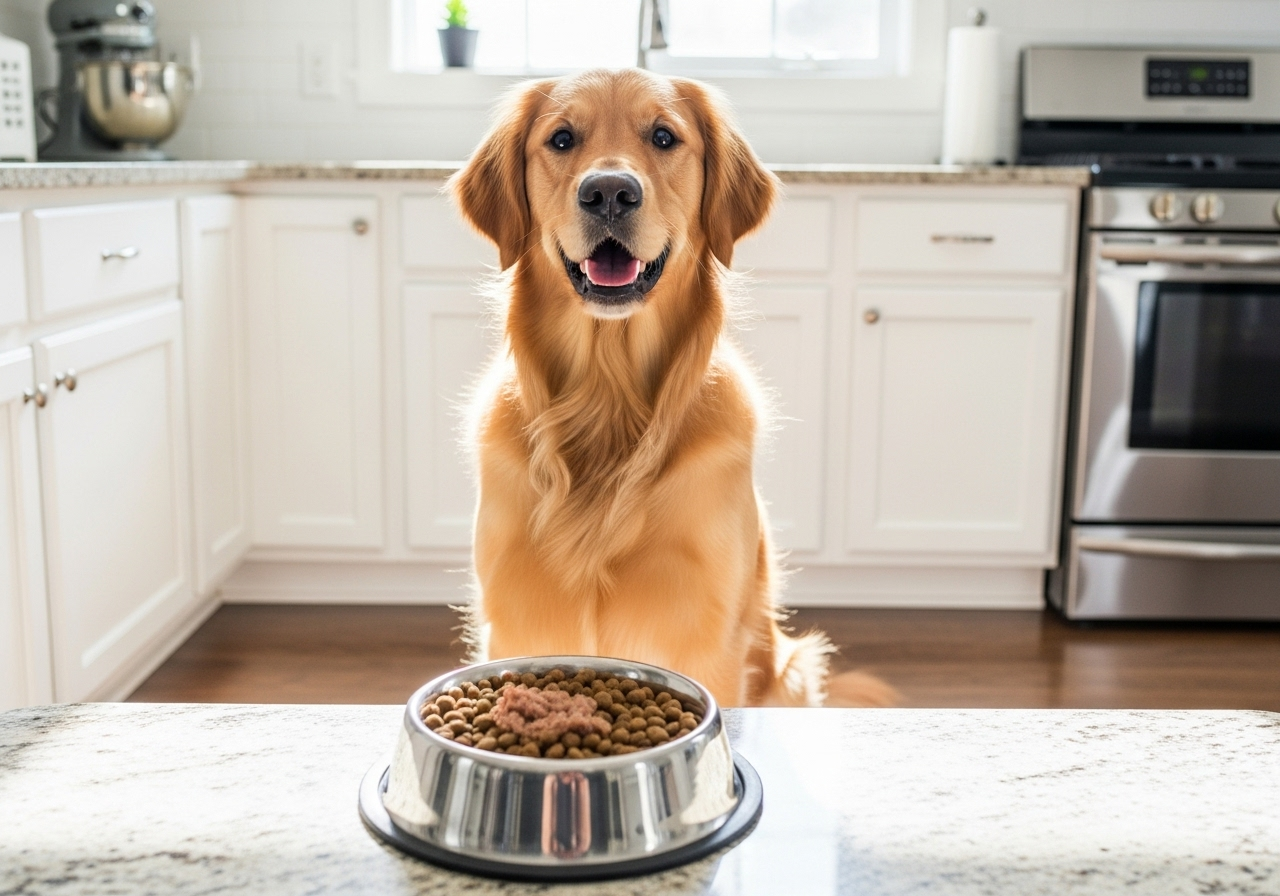Table of Contents
Medical Disclaimer: This article is for informational purposes only and does not constitute medical advice. The content is not intended to be a substitute for professional veterinary advice, diagnosis, or treatment. Always seek the advice of your veterinarian with any questions you may have regarding your pet’s medical condition.
Key Takeaways
Feeling overwhelmed by the debate over grain-free dog food and heart disease? Here’s what you truly need to know. The U.S. Food and Drug Administration (FDA) is investigating reports of a heart condition called dilated cardiomyopathy (DCM) in dogs eating certain diets, many of which are labelled “grain-free.”
However, there is no definitive proof that the absence of grain is the cause. The issue appears to be more complex, likely related to specific ingredients like high levels of peas, lentils, and other legumes, and how these ingredients affect the body’s use of vital nutrients like taurine. The best approach is not to panic, but to learn how to evaluate your dog’s food, watch for subtle signs of illness, and work closely with your veterinarian. This guide will help you do just that.
A Personal Note from My Practice
As a veterinarian, I’ve seen the worry on my clients’ faces. You want to do the absolute best for your dog, and you’ve spent a considerable amount of money on a food you believed was healthier. Then, you see a scary headline linking grain-free dog food and heart disease, and suddenly that bag of kibble feels like a betrayal. I get it.
In my clinic, the conversation almost always starts the same way: “Doc, I saw this thing online. Should I switch foods right now?” My answer is always to pause, take a breath, and let’s look at the facts together. The science is still evolving, but by focusing on what we do know, we can make calm, informed decisions for your pet.
What Is Dilated Cardiomyopathy (DCM) Anyway?

Before we dive into the food debate, it’s important to understand the condition at the centre of it. Dilated cardiomyopathy, also known as DCM, is a condition affecting the heart muscle.
How a Healthy Heart Works
Think of your dog’s heart as a strong, muscular pump. Its thick walls contract powerfully to send oxygen-rich blood to the rest of the body. It’s an efficient, powerful, and life-sustaining engine.
What Happens in a Dog with DCM
In a dog with DCM, the heart muscle becomes thin, weak, and stretched out. As the Merck Veterinary Manual explains, these weakened chambers can’t pump blood effectively. The heart becomes enlarged (dilated) and struggles to function, which can eventually lead to congestive heart failure. While certain breeds like Dobermans and Great Danes have a known genetic predisposition to DCM, the recent concerns have revolved around “atypical” cases in breeds not normally at high risk, which is what triggered the investigation into grain-free dog food and heart disease.
The FDA Investigation: Unpacking the Headlines About Grain-Free Dog Food and Heart Disease
The story exploded in July 2018 when the FDA first announced it was looking into a potential link between certain diets and DCM. This is where most of the public concern about grain-free dog food and heart disease originates.
What the FDA Found (and What It Didn’t)
The FDA’s investigation identified hundreds of cases of DCM in dogs eating diets labelled “grain-free.” However, it’s crucial to understand what this means. The FDA has not found a direct, causal link. It is an association, not a definitive “cause-and-effect.”
The agency has been careful to state that the issue appears to be complex and may involve multiple factors. As one comprehensive review in the Journal of Animal Science points out, simply being grain-free may not be the problem. This has led researchers to look more closely at what these diets contain, rather than just what they lack.
Why the Focus on Peas, Lentils, and Legumes?
In its updates, the FDA noted that more than 90% of the reported diets had a main ingredient of peas, lentils, or other legume seeds (also known as pulses), or potatoes. These ingredients were often used to replace traditional grains like corn, wheat, and rice.
This has become a key part of the conversation around grain-free dog food and heart disease. The suspicion is not on legumes themselves, which can be a healthy part of a diet, but on their use in very high quantities and how they might interfere with the availability or metabolism of essential nutrients.
Beyond the Bag: Is It the Lack of Grains or the New Ingredients?
Also see: https://doglifeexpert.com/reasons-the-leptospirosis-vaccine-in-dogs/

When I talk to clients, this is the most important shift in thinking. The problem likely isn’t about an absence of grains, but rather the nutritional consequences of what has been used to replace them.
The Role of Taurine
Taurine is an amino acid that is critical for heart health. Dogs can make their taurine from two other amino acids, methionine and cysteine. For a long time, taurine deficiency was not considered a major concern for most dogs.
However, the groundbreaking 2018 study in JAVMA that helped trigger the FDA alert found that many of the affected Golden Retrievers were taurine-deficient. When their diets were changed and they were given taurine supplements, their heart conditions often improved dramatically. This has led to a leading theory: that high levels of legumes might be binding with the building blocks of taurine or otherwise interfering with its absorption and use in the body, creating a functional deficiency. The link between grain-free dog food and heart disease may be a link between certain ingredients and taurine.
Formulation and Digestibility: The Bigger Picture
Pet food formulation is a science. It’s a delicate balance of proteins, fats, carbs, fibre types, vitamins, and minerals. Changing one major component, like swapping corn for peas, can have ripple effects throughout the entire nutritional profile. Some experts believe that the high fibre content or unique starches in legumes could affect the digestibility of the entire diet, leading to nutrient losses. This is why you can’t just judge a food by its “grain-free” label; the overall quality of the formulation and the manufacturer’s research and testing protocols are what truly matter.
Your 5-Minute “At-Home Heart Health” Checklist

While a definitive diagnosis requires a vet, you are the expert on your dog. Worried about grain-free dog food and heart disease? Watch for these subtle, early signs.
- Low Energy or Lethargy: Is your dog tiring more easily on walks? Are they less interested in playing?
- Coughing or Gagging: A persistent, dry cough, especially after lying down or in the morning, can be an early sign of heart strain.
- Changes in Breathing: Notice faster breathing or more effortful breaths, even when resting.
- Reduced Appetite: A gradual decrease in appetite can signal that your dog isn’t feeling well.
- Collapse or Fainting: This is a serious sign. If your dog ever faints or has a sudden episode of weakness, seek veterinary care immediately.
If you notice any of these signs, it doesn’t automatically mean your dog has DCM, but it does warrant a phone call to your vet.
Diagnosing Diet-Associated DCM in Canada: What to Expect
If you and your vet decide to investigate, the process is straightforward. We’ll start with a thorough physical exam, listening carefully to the heart and lungs.
From there, we may recommend:
- Blood Tests: Including a test called NT-proBNP, which is a marker for heart stretch and stress, and a taurine level test (both whole blood and plasma).
- Echocardiogram: This is an ultrasound of the heart. It’s the gold standard for diagnosing DCM, as it allows us to see the heart muscle, measure its thickness, and assess its pumping function.
A Table of Typical Canadian Diagnostic Costs
Navigating vet costs can be stressful. Here’s a rough estimate of what you might expect to pay in Canada for diagnostics related to grain-free dog food and heart disease. Prices are estimates and will vary significantly by province and clinic.
| Diagnostic Test | Estimated Cost Range (CAD) |
| Initial Vet Consultation & Exam | $80 – $150 |
| NT-proBNP Blood Test | $150 – $250 |
| Whole Blood & Plasma Taurine Test | $200 – $400 |
| Echocardiogram (Heart Ultrasound) | $500 – $900 |
4 Practical Steps to Choosing a Safe Dog Food Today
- Look Beyond the Marketing: Don’t be swayed by buzzwords like “ancestral” or “biologically appropriate.” Instead, flip the bag over. When it comes to grain-free dog food and heart disease, the ingredient list is more telling than the front of the bag. If peas, lentils, or potatoes are listed as the first few ingredients, ask more questions.
- Choose a Company That Invests in Research: Look for brands that employ full-time veterinary nutritionists and conduct feeding trials that meet World Small Animal Veterinary Association (WSAVA) guidelines. These companies are more likely to have rigorous quality control.
- Consider a Grain-Inclusive Diet: If you don’t have a specific, vet-diagnosed reason for feeding grain-free (like a rare grain allergy), consider a diet that includes grains. Grains like corn and wheat have been used in dog food for decades and are rarely a source of problems for the vast majority of dogs.
- Talk to Your Vet: This is the most important step. Your veterinarian can assess your dog’s health, discuss your concerns about grain-free dog food and heart disease, and help you choose a diet that is backed by science and appropriate for your pet’s life stage and lifestyle.
Frequently Asked Questions (FAQs)
So, does grain-free dog food cause heart disease?
There is no simple “yes” or “no.” The current evidence points to a complex association, not a direct cause. The link appears to be with specific formulations, particularly those high in legumes and potatoes, rather than all grain-free dog food and heart disease being a universal problem.
My dog is doing great on a grain-free diet. Do I have to switch?
Not necessarily. The first step is to have a conversation with your vet. You can discuss the specific brand you’re feeding, your dog’s breed and health status, and whether any screening tests would be a good idea for peace of mind.
Are there “safe” grain-free diets?
This is the million-dollar question. Without a definitive cause, it’s hard to say. A safer approach might be to choose a diet from a well-established company that conducts extensive research and feeding trials, and one that doesn’t use extremely high levels of legumes as its primary ingredients.
What if my dog has a diagnosed grain allergy?
True grain allergies are very rare in dogs; they are much more likely to be allergic to a protein source like chicken or beef. If your dog truly has a grain allergy confirmed by your vet, work with them to find a suitable diet that avoids the specific grain while still being from a reputable manufacturer.
The Bottom Line on Grain-Free Dog Food and Heart Disease

The connection between grain-free dog food and heart disease is a real and ongoing area of veterinary research. It is a nuanced issue that is more about specific formulations and ingredients than a simple “grains vs. no grains” debate. For now, the best path forward is one of educated awareness, not panic. Read labels, choose reputable brands that invest in science, and keep an open dialogue with your veterinarian. Your dog depends on you to be their advocate, and by staying informed, you are doing exactly that.





Pingback: Raw Food Diet for Dogs: The best 2025 Vet-Reviewed Guide